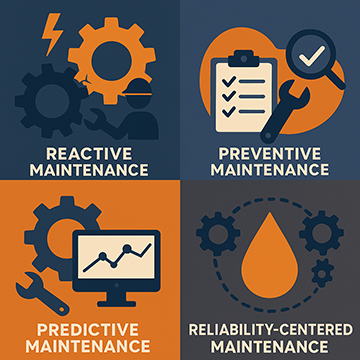Published: July 14, 2025 | Updated: October 23, 2025
Published: July 14, 2025 | Updated: October 23, 2025
Maintenance Strategies to Maximize Asset Longevity
 Every company with physical assets recognizes the critical role of upkeep. Businesses aim for extended asset life and consistent reliability while carefully managing expenses. This discussion explores four pillars of maintenance strategy for prolonged asset life.
Every company with physical assets recognizes the critical role of upkeep. Businesses aim for extended asset life and consistent reliability while carefully managing expenses. This discussion explores four pillars of maintenance strategy for prolonged asset life.
Choosing the Right Approach
How to Choose the Right Maintenance Strategy for Your Business
Selecting a maintenance strategy involves considering various business factors. Industry type, available resources, budgetary constraints, and technological capabilities all influence this decision. A thorough evaluation of these elements guides the choice of the most suitable approach for a given operation.
The Four Core Maintenance Strategies Explained
This exploration delves into the following types of maintenance:
- Reactive
- Preventive
- Predictive
- Reliability-Centered
The analysis also includes industry examples and examines how a computerized maintenance management system (CMMS) supports each strategy.
Reactive Maintenance: A Basic Strategy for Non-Critical Assets
Often known as "break-fix" maintenance, this method represents the most fundamental approach. It involves repairing or replacing equipment only when a failure occurs.
Advantages of Reactive Maintenance
- Low initial investment: Companies avoid large inventories of parts and supplies, perhaps keeping only a few critical items on hand.
- Simple implementation: Setting up this approach may involve maintaining an on-call team of technicians.
- Suitable for low-value, low-risk assets: This strategy works best for equipment where failure poses minimal disruption or cost.
Disadvantages of Reactive Maintenance
- Unexpected downtime: Waiting for asset failure means operations face unpredictable interruptions. Production delays frequently occur.
- Increased maintenance costs: Teams may require call-outs during off-hours, potentially incurring overtime and necessitating emergency purchases. A failure might even lead to complete asset replacement.
- Potential safety hazards: Ignoring potential issues until a failure arises increases the risk of safety problems, causing further equipment damage and potential employee injuries, adding to overall liability.
- Difficulty in planning and scheduling: This approach tackles problems as they arise, making it hard to prioritize or schedule multiple urgent issues. The "wait until a problem happens" mindset eliminates opportunities for proactive repair planning.
Industry Examples of Reactive Maintenance
- Small businesses: Limited resources often lead small businesses to adopt a reactive stance toward equipment upkeep.
- Emergency services: Emergency personnel sometimes adopt a reactive mindset, encountering similar risks as other sectors.
Discover how streamlined maintenance processes can elevate production. Learn more.
Preventative Maintenance: A Proactive Strategy to Extend Asset Life
Many companies consider preventive maintenance (PM) a highly effective method. This approach involves performing scheduled inspections, cleaning, and part replacements to prevent equipment failures. This proactive strategy significantly reduces unexpected downtime and prolongs asset lifespan. While PM requires upfront planning and investment, it greatly enhances operational efficiency and reliability.
Advantages of Preventive Maintenance
- Reduced unexpected downtime: A regular PM cycle helps discover issues before they escalate into major problems. Often, simple cleaning and lubrication prevent many failures.
- Extended asset lifespan: PM routines include replacing worn parts, which directly extends the life of assets. Consistent attention keeps equipment in prime working condition.
- Improved operational efficiency: Regular monitoring and PMs ensure equipment runs as designed, consuming less energy and maintaining consistent quality output.
- Enhanced safety: Proactive identification and repair of potential safety issues occur before incidents happen.
- Predictable maintenance costs: Companies gain better control over budgeting and purchasing, making expenses more foreseeable.
Disadvantages of Preventive Maintenance
- Higher upfront costs: Proper PM necessitates a larger inventory of parts and supplies on hand.
- Potential for over-maintenance: Sometimes, excessive attention leads to production interruptions or even creates new problems. For example, over-lubricating equipment offers no benefit.
- Requires planning and scheduling: A supervisor or dedicated planner must dedicate time to plan and schedule these maintenance tasks.
- May not address all potential failure modes: With busy schedules, a PM routine might not cover every aspect needing attention, potentially missing reasons for specific machine failures.
Industry Examples of Preventive Maintenance
- Manufacturing: Manufacturing facilities often implement preventive maintenance schedules for critical equipment to ensure uninterrupted production.
- Aviation: Airlines adhere to strict preventive maintenance protocols, crucial for maintaining aircraft safety and reliability.
Predictive Maintenance: Data-Driven Strategy to Reduce Failures
Predictive maintenance (PdM) employs advanced technologies, including sensors, data analytics, and condition monitoring, to foresee potential equipment failures. By analyzing equipment performance data, predictive maintenance enables proactive interventions, minimizing downtime and allocating resources effectively.
Advantages of Predictive Maintenance
- Minimized downtime: This strategy identifies and resolves issues before they cause significant operational halts.
- Resource allocation: Historical data informs better scheduling of technicians and procurement of necessary inventory.
- Improved equipment reliability: Similar to PMs, PdM keeps equipment running consistently.
- Early detection of potential failures: PdM often uncovers issues earlier than even preventive maintenance.
- Reduced maintenance costs: In the long run, like PMs, predictive maintenance lowers expenses by avoiding the problems associated with a reactive strategy.
Disadvantages of Predictive Maintenance
- Higher initial investment in technology: Implementing PdM requires a proper budget for necessary technology.
- Requires data analysis expertise: Companies may need to hire professionals skilled in interpreting data.
- Potential for false positives or negatives: Not all technology performs perfectly, occasionally requiring extra steps or testing for verification.
- May not suit all types of equipment: PdM is not universally applicable across industries. The specific equipment used may make this method unfeasible.
Industry Examples of Predictive Maintenance
- Oil and gas: Predictive maintenance monitors critical equipment, such as pumps and compressors, in this sector.
- Power generation: Power plants utilize predictive maintenance techniques to ensure the reliability and efficiency of their generating units.
Reliability-Centered Maintenance: Strategic Focus on Critical Assets
RCM focuses on identifying the critical functions of equipment and the failure modes that can affect those functions. By understanding the consequences of failures, RCM helps determine the most effective maintenance tasks to prevent or mitigate them.
Advantages of Reliability-Centered Maintenance
- Tailored maintenance strategies: This method offers a more focused plan than general PMs.
- Focus on critical functions: RCM prioritizes important and necessary assets. Companies might apply RCM to vital assets while using PMs or even reactive maintenance for less critical equipment.
- Reduced unnecessary maintenance: The intense focus often leads to conducting fewer, more impactful jobs.
- Improved equipment reliability: A consistent benefit across three of the four strategies.
- Enhanced safety: This focused approach helps pinpoint potential hazards effectively.
Disadvantages of Reliability-Centered Maintenance
- Requires in-depth analysis: Similar to PdM, RCM necessitates skilled analytical capabilities.
- Can be time-consuming to implement: Setting up and initiating this method requires significant effort.
- May pose complexity issues for large-scale operations: Due to size, large companies might have numerous "critical" systems. Implementing RCM in these environments could potentially hinder production and proper upkeep.
Industry Examples of Reliability-Centered Maintenance
- Aerospace: The aerospace industry extensively uses RCM to ensure the safety and reliability of aircraft components.
- Nuclear power: RCM holds critical importance for maintaining the safety and integrity of nuclear power plants.
Selecting the Right Maintenance Strategy for Asset Longevity
The ideal maintenance strategy for a company depends on various factors, including equipment type, its criticality, the cost of potential failure, and available resources. A combination of strategies may address different equipment and operational requirements.
Key Considerations When Selecting a Maintenance Strategy
- Equipment criticality: For critical equipment, predictive or RCM approaches often show greater benefits.
- Cost of failure: If the cost of equipment failure is high, proactive strategies like preventive or predictive maintenance offer more advantages.
- Available resources: The availability of personnel, technology, and budget needs careful study when selecting a maintenance strategy.
- Regulatory requirements: Certain industries may have specific regulatory requirements that dictate the maintenance practices to be followed.
The Role of a CMMS in Maintenance Strategies
Many companies utilize CMMS software to help organize existing maintenance departments. This system provides a centralized platform for tracking equipment information, scheduling maintenance tasks, managing inventory, and generating reports.
CMMS Benefits for Asset Tracking and Maintenance Efficiency

- Reactive maintenance: While having a constant reactive maintenance mindset incurs issues such as extra costs and shortened asset life, companies will have reactive maintenance, in that assets will fail or break down. However, you can minimize these incidents with a CMMS. A CMMS tracks equipment failures, generates work orders, and managers can create reports to study patterns to shape preventive measures.
- Preventive maintenance: A CMMS schedules preventive maintenance tasks, tracks equipment inspections, and generates maintenance history.
- Predictive maintenance: A CMMS can register readings and give information for predictive analyses, enabling better maintenance planning.
- RCM: A CMMS supports RCM by providing a platform for documenting equipment functions, failure codes, and maintenance tasks.
Aligning Maintenance Strategies with Long-Term Asset Longevity
Deciding which of the four maintenance strategies to employ, or if a combination works best, requires careful consideration. Discussions with relevant personnel from production, maintenance, and management provide valuable insights. Each department contributes important information to the decision-making process. The selection of a maintenance strategy requires periodic monitoring and adjustment. Businesses and operational methods evolve constantly. Companies should always look for new technology and more effective ways of operating. Selecting a quality CMMS will help organize and track all of your maintenance strategies.
FAQs
What are the four main maintenance strategies?
The four core maintenance strategies are reactive, preventive, predictive, and reliability-centered maintenance, each serving different operational needs.
How does preventive maintenance help extend asset life?
Preventive maintenance involves scheduled inspections and repairs to reduce breakdowns, extend asset lifespan, and improve efficiency.
What is predictive maintenance and how does it work?
Predictive maintenance uses sensors, data analytics, and monitoring tools to detect issues early and prevent equipment failures before they occur.
Why is reliability-centered maintenance important?
Reliability-centered maintenance focuses on critical assets, ensuring essential equipment receives the most effective and targeted maintenance actions.
How can a CMMS support maintenance strategies?
A CMMS helps organize and track all maintenance types—reactive, preventive, predictive, and RCM—by scheduling tasks, managing assets, and generating reports.
What makes MAPCON’s CMMS valuable for maintenance management?
MAPCON’s CMMS offers automation, reporting, and asset tracking tools that streamline maintenance planning and help maximize asset longevity.
MAPCON | 800-922-4336
MAPCON CMMS software empowers you to plan and execute PM tasks flawlessly, thanks to its wealth of features and customizable options. Want to see it for yourself? Click the button below to get your FREE 30-day trial of MAPCON!
Try It FREE!